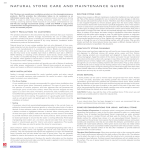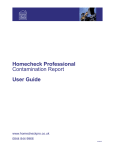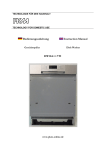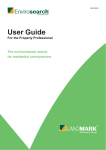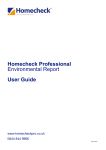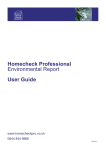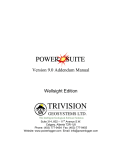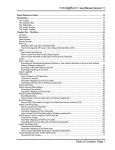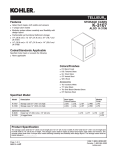Download Homecheck Professional Ground Stability Report User Guide
Transcript
Homecheck Professional Ground Stability Report User Guide www.homecheckpro.co.uk 0844 844 9966 20/06/07 User Guide Table of Contents Introduction - About this Guide 3 Why should I get a Homecheck Professional Ground Stability Report? 3 When should I get a Homecheck Professional Ground Stability Report? 3 How do I get a Homecheck Professional Ground Stability Report? 4 What is my Homecheck Professional Ground Stability Report telling me? 4 How do I proceed now? 8 Appendix Appendix 1: Potential Mining Areas 9 Appendix 2: Data sets used in the Homecheck Professional Ground Stability Report 14 2 1. Introduction – about this Guide 1.1 This Guide has been prepared by Landmark Information Group to assist busy conveyancing practitioners to decide: Whether to obtain a Homecheck Professional Ground Stability Report on behalf of their clients. What that search reveals. What steps they should take next, in the best interests of their clients. 1.2 The Guide is not intended to usurp the role of the professional advisor, who is uniquely placed to view the whole transaction in consultation with the client, but it is intended to inform that discussion and provide guidance to the advisor in that situation on how to progress the matter speedily, efficiently and cost-effectively. 1.3 It is intended that this Guide is regularly updated to keep pace with the rapid changes to the conveyancing process and to reflect the role which accurate and dependable environmental information plays in that process. Copies of this Guide are available free of charge from www.homecheckpro.co.uk. Alternatively call the Homecheck Professional Ground Stability Report helpline on 0844 844 9966 or email [email protected]. 2. Why should I get a Homecheck Professional Ground Stability Report? 2.1 High profile media coverage of properties affected by subsidence offers a timely reminder to the practitioner of the importance of ground stability. As an authorised element of the future Home Information Pack, the Homecheck Professional Ground Stability report represents the first widely available information covering all types of mining and other ground stability issues. It is a valuable screening tool allowing potential risks to be identified in a timely and cost effective manner. 2.2 A Homecheck Professional Ground Stability Report will give the practitioner as much information as is currently economically available, in an accurate and dependable form, on which to base the discussions and advice to their client. 3. When should I get a Homecheck Professional Ground Stability Report? 3.1 We recommend that a Homecheck Professional Ground Stability Report should be obtained in connection with any dealing or valuation to do with domestic property, including purchase, mortgage, or further advance, or before any domestic building work, such as self-build or an extension, is undertaken. The report should be obtained before exchange of contracts or any other form of binding obligation. 3.2 The Homecheck Professional Ground Stability Report is intended for individual domestic properties only. 3 4. How do I get a Homecheck Professional Ground Stability Report? 4.1 A Homecheck Professional Ground Stability Report can be ordered by using one of our order forms or alterntively via our website at www.homecheckpro.co.uk. To obtain an order form or register for an account to order online please contact: Landmark Information Group Limited Legal & Financial The Smith Centre Fairmile Henley-on-Thames RG9 6AB Telephone: Fax: DX: E-mail: Internet: 0844 844 9966 0844 844 9980 154400 Henley-on-Thames 2 [email protected] www.homecheckpro.co.uk 4.2 A separate search should be made for each individual property having a different postal address. 4.3 Order forms should be completed by including: The full postal address and postcode of the property. The name and Document Exchange (DX) number (if applicable) of the practitioner. The practitioner’s file reference and telephone number. A plan of the property (see paragraph 4.4 below). 4.4 If you are using an order form it is requested that a plan showing the location of the property is enclosed with your order. If a plan is not supplied there may be difficulties in identifying the location of the property and this may introduce a delay. 4.5 In normal circumstances a Homecheck Professional Ground Stability Report will be despatched to the practitioner within 24 to 48 hours of the receipt of the order. 4.6 The Homecheck Professional Ground Stability Report is also available electronically, normally within 24 hours. 5. What is my Homecheck Professional Ground Stability Report telling me? 5.1 The report will include information from a number of statutory and non-statutory sources, and also provides guidance on the presence of a feature that could create a subsidence hazard, whether natural or man made. This allows the legal professional to screen for potential risks and and identify any need to engage a surveyor or structural engineer on specific issues. 4 5.2 Sitescope has agreements for the supply or collection of data with a number of national data providers. Notably, Sitescope is a Licensed Partner of Ordnance Survey and a Value Added Reseller for the Coal Authority and British Geological Survey. The currency of the datasets used is determined by the frequency of updates by the data providers under their respective agreements with Sitescope. 5.3 Any person relying on a Homecheck Professional Ground Stability Report must comply with the attached Terms and Conditions. 5.4 The replies in the Homecheck Professional Ground Stability Report will be given in the belief that they accord with the data sets and update cycles listed in Appendix 2, but on the understanding that Sitescope is not legally responsible for them except as detailed in the Terms and Conditions, which may vary from time to time. 5.5 Sitescope is constantly working with data providers to improve the data sets and the information available to Sitescope may change. Accordingly, there is no protection period relating to a Homecheck Professional Ground Stability Report and practitioners should not attempt to rely on a previous report. Practitioners who rely on a previous report will not have the benefit of Sitescope’s Professional Indemnity Insurance cover. 5.6 Practitioners should note that addresses may have been compared to the Royal Mail Postal Address File standard and therefore may have been changed to comply with this standard. 5.7 The report is split into a summary section, which gives basic information in an easy to understand question and answer format, and an additional information section which gives further details if records are revealed. 5.8 The practitioner should normally be able to easily verify that the report has been correctly located on the subject property using the Site Location map. In the event of any doubt as to the correct location the practitioner should raise this immediately with the agent. Enquiries and Replies 5.9 The Homecheck Professional Ground Stability Report will be based on the information listed in Appendix 2 to this Guide. The practitioners’ attention is drawn to the update cycles for this information. 5.10 The Homecheck Professional Ground Stability Report uses the boundary of the property as the basis of the search if this is digitised. Alternatively, the search can be ordered as a point location and our system will construct a 25m radius circle around this point which will be used as the property boundary for the purposes of the report. Please note that use of the 25m circle is not an attempt to make an approximation of the property boundary. 5 5.11 Section A of the report contains Enquiries relating to Mining. The enquiries relate to land within 0 - 250 metres from the property boundary. No additional information is provided for section A3 and only the additional information for section A5 includes a location map, if records are revealed as the data for the other sections is not mapped. These answers are drawn from the following data sets: Mining Instability (Ove Arup & Partners). Potential Non Coal Mining Areas (Wardell Armstrong LLP). Coal Mining Affected Areas (The Coal Authority). Shallow Mining Hazards (BGS). Natural and Mining Cavities (Peter Brett Associates). BGS Recorded Mineral Sites (BGS). Potentially Contaminative Industrial Uses (Past Land Use). The information provided relating to Potentially Contaminative Industrial Uses (Past Land Use) has been identified by the analysis of selected Ordnance Survey historical mapping and fall into the following categories: Air Shafts General quarrying Heap, unknown constituents Mineral railway Mining & quarrying general Mining of coal & lignite Quarrying of sand & clay, operation of sand & gravel pits 5.12 Section B of the Report contains Enquiries relating to Brine and Salt Extraction. The enquiries relate to land within 0 - 250 metres from the property boundary. No maps are included in the additional information section. The enquiries relate to the following: Brine Compensation Areas (Cheshire Brine Subsidence Compensation Board). Brine Pumping Related Features (Wardell Armstrong LLP). 6 5.13 Section C of the Report contains Enquiries relating to Man Made Stability Hazards. The enquiries relate to land within 0 - 250 metres from the property boundary, with the exception of BGS Boreholes which relate to land within 50 metres. Only the additional information sections for C2, C3 and C4 include a location map as the data for the other sections is not mapped. The enquiries relate to the following: Potentially Contaminative Industrial Uses (Past Land Use). Former Marshes. Potentially Infilled Land (Non-Water). Potentially Infilled Land (Water). BGS Recorded Landfill Sites (BGS). Registered Landfill Sites (The Environment Agency). Local Authority Recorded Landfill Sites (Local Authorities). Licensed Waste Management Facilities (Landfill Boundaries) (The Environment Agency). Licensed Waste Management Facilities (Locations) (The Environment Agency). BGS Boreholes (BGS). The information provided relating to Potentially Contaminative Industrial Uses (Past Land Use) has been identified by the analysis of selected Ordnance Survey historical mapping and relate to the category of Disturbed Ground. 5.14 Section D of the Report contains Enquiries relating to Natural Ground Stability Hazards.The enquiries relate to land within 0 - 250 metres from the property boundary. No maps are included in the additional information section. The enquiries relate to the following: Potential for Landslide Ground Stability Hazards Potential for Ground Dissolution Stability Hazards Potential for Compressible Ground Stability Hazards Potential for Shrinking or Swelling Clay Ground Stability Hazards Potential for Running Sand Ground Stability Hazards Potential for Collapsible Ground Stability Hazards All these data sets are provided by the BGS. 7 6. How do I proceed now? 6.1 The Homecheck Professional Ground Stability Report constitutes what is known as a “desk-study”, occasionally known as a “screening report”, which is an information-gathering source. The information revealed in the search report is a starting point for further investigation. It cannot give definitive answers to what problems actually affect individual properties. 6.2 The practitioner will now need to discuss the implications of the information provided with the client and others involved in the purchase transaction, including lenders and other professionals, to decide how best to proceed. 6.3 Essentially, the Report will show either: No identifiable problem. Entries in relation to which further advice/further investigation may be necessary. 6.4 The decision whether to proceed, undertake further investigations or withdraw must be the client’s, and it will frequently depend on factors unrelated to the information revealed by the search. Factors such as the cost of the further investigations, the difficulty or delay involved in undertaking them, the accuracy and helpfulness of the further information revealed, the general time scale of the transaction and the client’s attitude to risk will all influence the decision. 6.5 It cannot be over-emphasised that until the actual extent of a potential problem is investigated and revealed, a practitioner cannot fully advise on its implications, and the Homecheck Professional Ground Stability Report is only designed to provide the information to enable practitioners to identify the next questions. 6.6 The report should be kept with the title deeds, along with other important documentation. 8 Appendix 1: Potential Mining Areas The following categories of minerals are contained in the Potential Mining Areas data. Mineral Anhydrite Description Location Anhydrite is white, sometimes greyish, bluish or purple calcite mineral which, when exposed to Originally found in Cumbria, Nottinghamshire, water, readily transforms to the more commonly occurring gypsum. It is most frequently found East Sussex, Leicestershire and Staffordshire, in salt deposits within a gypsum area, where depth is the critical factor. The nearer the surface with the East Midlands being the most important the more likely anhydrite will be altered to gypsum by absorption of circulating ground water. area. It was used as a source of sulphur for use in fertilizers and as a constituent of sulphuric acid. Demand is currently very low and the last mine devoted to production for sulphuric acid closed in 1975. Arsenic Arsenic is a notoriously poisonous metalloid that is used in pesticides, herbicides, insecticides The majority of arsenic mining was conducted and various alloys. It is chemically very similar to phosphorus and the fumes given off when it oxidises have an odour resembling garlic. Lead hydrogen arsenate has been used, well into the 20th century, as an insecticide on fruit trees (resulting in neurological damage to those working the sprayers. The historical application of most concern to the general public is in Cornwall and West Devon, accounting for both mineral deposits and spoil heaps, although there are also very small natural concentrations in the ground and stream water in Lincolnshire, probably that of wood which has been treated with chromated copper arsenate (CCA), and the Leicestershire, Oxfordshire & Northamptonshire. vast majority of older “pressure treated” wood). Ball Clay Ball clays consist chiefly of the clay mineral kaolinite, with a minor amount of montmorillonite It is especially concentrated in Dorset. and organic material. Ball clay is lightweight, chalk-like in appearance, and used in china, whiteware, and various ceramic products. Bauxite Bauxite is a sedimentary rock produced by in situ chemical weathering typically under tropical Major world concentrations are in Australia & to subtropical climate conditions. It is the raw material most widely used in the production of Brazil. UK historic mining was highly localised aluminium on a commercial scale. and focused along the south coast. Chalk In England the Chalk topographically forms what are known as the ‘Downs’ in southern and There are specific concentrations of past mining eastern counties. It is exposed in quarries and roadcutting but the best exposures are along activity in Kent, Berkshire, Hertfordshire, Norfolk the coastlines where Chalk often forms spectacular clifflines, the most famous of which are and Buckinghamshire. the ‘White Cliffs of Dover.’ It is comprised of a sequence of mainly soft, white, very fine-grained extremely pure limestones which are commonly 300-400 m thick. In Yorkshire the chalk of the Yorkshire wolds and the cliffs at Scarborough are much harder than the chalks of Southern England. Chalk cliffs, due to their weakness, erode relatively quickly, yet the interbedding of weak and stronger layers allows high cliffs to form. When these fail, large landslips occur. Finely prepared chalk, used as a drawing implement, most commonly in teaching. It is both used in the making of cement, it is a fertilizer for farmland and as a flux in smelting copper and lead ores and in making iron and steel. China Clay China Clay (or Kaolinite) is a layered silicate mineral, It is a soft, earthy, usually white mineral Deposits in central Cornwall near to St Austell produced by the chemical weathering of silicate minerals like feldspar. are the largest in the world. They have been Kaolinite is one of the most common minerals. Due to its extremely fine nature (finer than silt), it is mixed with water and transported in tanks as a liquid slurry. It is used in ceramics, medicine, bricks, coated paper, as a food additive, in toothpaste, as a light diffusing material in white incandescent light bulbs, and in cosmetics. A recent use is as a specially formulated spray applied to fruits, vegetables, and other vegetation to repel or deter insect damage. A extracted since 1746 totalling some 120 million tons, but reserves in the ground will last at least another hundred years. There are also concentrations near Carlisle, Cumbria. traditional use is to soothe an upset stomach. Clay The term “clay” is applied to various earthy materials composed dominantly of hydrous Well known concentrations of clays include aluminum magnesium silicate minerals. The most familiar characteristic of clay is plasticity or London, Essex and Cambridgeshire. the ability of moist clay to be fashioned into a desired shape. The physical properties of a clay are plasticity, strength, and refractoriness. Plasticity enables the clay to be molded; strength permits it to be handled during the forming, drying, and burning processes; and refractoriness permits it to be burned into a hard body of permanent form. Clay is especially susceptible to changes in climate and hydrology and the action of shrinking and swelling can be a major contributor to subsidence and heave. 9 Appendix 1: Potential Mining Areas The following categories of minerals are contained in the Potential Mining Areas data. Mineral Coal Description Location Coal is a fossil fuel extracted from the ground by underground mining or open-pit mining Coal is now only mined in 9 specific sites, with (surface mining). It is a readily combustible black or brownish-black sedimentary rock. It is historic mining activity including South Wales, composed primarily of carbon along with assorted other elements, including sulphur. Often Nottinghamshire, South Yorkshire, East Kent, associated with the Industrial Revolution, coal remains an enormously important fuel and is County Durham, Bristol & Bath, West Midlands, the largest single source of electricity world-wide. Northumbria & Lancashire. Other constituents of coals include mineral matter, usually as silicate minerals such as clays, illite, kaolinite and so forth, as well as carbonate minerals like siderite, calcite and aragonite. Iron sulphide minerals such as pyrite are common constituents of coals. Sulphate minerals are also found, as is some form of salt, trace amounts of metals, notably iron, uranium, cadmium, and (rarely) gold. Methane gas is another component of coal, produced not from bacterial means but from methanogenesis. Methane in coal is dangerous, as it can cause coal seam explosions, especially in underground mines, and may cause the coal to spontaneously combust. It is, however, a valuable by-product of some coal mining, serving as a significant source of natural gas. Areas with specific methane gas potential include South Wales, Wirral , Staffordshire and Cumbria Coal was not mined in Britain before the high Middle Ages; i.e. after 1000 AD, initially as informal mines, but increasingly deeper shafts were bored with the onset of the industrial revolution. Cobalt Copper Cobalt is a hard, lustrous, silver-grey metal, is found in various ores and is used in the preparation of magnetic, wear-resistant, and high-strength alloys. Its compounds are used in the production of Cobalt is usually not mined alone, and tends to be produced as a by-product of nickel and copper mining activities, and varnishes. Cobalt-60 has multiple uses as a gamma ray source in radiotherapy, treatment of foods for sterilization (cold pasteurization) and in Cobalt is usually not mined alone, and tends radiography to detect structural flaws in metal parts. Cornwall; Alderley Edge, Cheshire & Central Wales with corresponding silver-lead-zinc veins. to be produced as a by-product of nickel and copper mining activities. It was not commonly found across the UK, but was recovered in conjunction with copper mines near Camborne, Copper is a reddish coloured metal, with a high electrical and thermal conductivity (among pure Copper has been mined since the Bronze metals at room temperature, only silver has a higher electrical conductivity). In oxidation is mildly Age across the British Isles, but mainly in basic. Copper has its characteristic colour because it reflects red and orange light and absorbs the following locations: West Wales (e.g. other frequencies in the visible spectrum, Cwmwystwyth) North Wales (e.g. Great Orme) Copper occupies the same family of the periodic table as silver and gold, hence it shares many Anglesey (Parys Mountain) Cheshire (Alderley characteristics with these metals Edge) Stafforshire (e.g. Ecton Mine) All copper compounds, unless otherwise known, should be treated as if they were toxic. An inherited condition called Wilson’s disease causes the body to retain copper, since it is not excreted by the liver into the bile. This disease, if untreated, can lead to brain and liver damage. In addition, studies have found that people with mental illnesses such as schizophrenia had heightened levels of copper in their systems. However it is unknown at this stage whether the copper contributes to the mental illness, whether the body attempts to store more copper in response to the illness, or whether the high levels of copper are the result of the mental illness. Evaporites Evaporites are sediments formed when mineral rich water evaporates. They are commonly Historic deposits can be found in Cheshire, found in areas of high evaporation, such as dried lakes. Derbyshire and Nottinghamshire. Fireclay Fireclay is a type of clay used for making firebricks and other items capable of withstanding Unlike conventional brick-making clay, it is high temperatures. Because of its stability during firing in the kiln, it can be used to make mined as a rock at depth, usually found as a complex items of pottery such as pipes and sanitary ware. seatearth associated with coal measures and distribution in the UK. Fluorspar Fluorite may occur as a vein deposit, especially with metallic minerals, where it often forms a One of the most famous of the older localities of part of the gangue (the worthless “host-rock” in which valuable minerals occur) and may be fluorite is Castleton in Derbyshire, England, associated with galena, sphalerite, barite, quartz, and calcite Beautiful purple-blue fluorite was used for ornamental purposes, especially in the 19th century. The name derives from French “bleu et jaune” (blue and yellow) characterising its colour. It is now scarce, and only a few hundred kilograms are mined each year for ornamental and lapidary use. Fullers Earth Fuller’s earth is any nonplastic clay or claylike material that can be used to decolourise, filter, It has been mined in the Vale of White Horse, in and purify animal, mineral, and vegetable oils and greases. It usually has a high magnesium Oxfordshire, England oxide content. It is a variety of montmorillonitic clay that is a natural bleach. It was originally used by fullers to “full” or remove grease from cloth; hence its name. Fuller’s earth is also used by military forces to clean soldiers who are contaminated with chemical weapons. It also finds use in special effects when simulating explosions. Fine-grained fuller’s earth makes a much larger plume than ordinary dirt, suggesting a larger explosion and allowing a smaller, safer charge to be used. Important uses are in absorbents and filters. Because of this, fuller’s earth is sometimes found in cat litter. Hills, cliffs and slopes containing fuller’s earth can be unstable, since this material clogs when saturated by heavy rainfall. 10 Appendix 1: Potential Mining Areas The following categories of minerals are contained in the Potential Mining Areas data. Mineral Description Location Ganister Ganister is hard, fine-grained quartzose sandstone, or orthoquartzite, used in the manufacture It is commonly, but not always found as of silica brick typically used to line furnaces. Ganisters are cemented with secondary silica and seatearths within English Carboniferous coal typically have a characteristic splintery fracture. Miners originally coined this term for hard, measures in the North of England. Gold Gold is a highly prized precious metal that for millennia has been used as money, a store of value and in jewelry. The metal occurs as nuggets or grains in rocks and in alluvial deposits and is the most malleable and ductile metal known; a single gram can be beaten into a sheet of one square meter, or an ounce into 300 square feet chemically and physically inert silica-cemented quartzose sandstones. The UK distribution is nothing compared to South Africa, for example. However, there are recorded mines in North & West Wales and the Forest of Dean. Due to its relative chemical inertness, gold is usually found as the native metal or alloy. Occasionally large accumulations of native gold (also known as nuggets) occur but usually gold occurs as minute grains. These grains occur between mineral grain boundaries or as inclusions within minerals. Granite Granite is a common and widely-occurring type of intrusive, felsic, igneous rock and is formed Past mining activity is concentrated around from magma. They can be pink to dark gray or even black, depending on their chemistry and Devon & Cornwall, Lleyn Peninsula, North mineralogy. Wales, Derbyshire and Cumbria. Outcrops of granite tend to form tors, rounded massifs, and terrains of rounded boulders cropping out of flat, sandy soils. Granites sometimes occur in circular depressions surrounded by a range of hills, Granite has been extensively used as a dimension stone and as flooring tiles in public and commercial buildings and monuments. With increasing amounts of acid rain in parts of the world, granite has begun to supplant marble as a monument material, since it is much more durable. Polished granite has been a popular choice for kitchen countertops due to its high durability and aesthetic qualities. Gravel Large gravel deposits are a common geological feature, being formed as a result of the weathering and erosion of rocks. The action of rivers and waves tends to pile up gravel in large concentrations. This can sometimes result in gravel becoming compacted and concreted into the sedimentary rock called conglomerate. Where natural gravel deposits are insufficient for human purposes, gravel is often produced by quarrying and crushing hard-wearing rocks, such as sandstone, limestone, or basalt. Quarries where gravel is extracted are known as gravel pits. Gritstone Gritstone is a sedimentary rock composed of coarse sand grains with inclusions of small It is commonly found in Derbyshire and stones. It is a coarser version of sandstone and is quarried for building material. British Yorkshire. gritstone was used for millstones, to mill flour and sharpen blades, giving rise to its other Southern England possesses particularly large concentrations of gravel due to the widespread deposition of gravel in the region during the Ice Ages, with specific concentrations in Surrey, Kent and Sussex. common name of millstone grit. The rock is much loved by British climbers among whom it has almost cult status and is often referred to as “God’s own rock”. The rough surface providing outstanding friction, allows climbers to stand on or grip the subtlest of features in the rock. Gypsum Gypsum is the more common name for a mineral compound called calcium sulphate There are concentrations in the West and East dihydroxide, or sulphate of lime. Gypsum is generally found underground near deposits of Midlands, Cumbria, North & South Yorkshire. limestone or other minerals formed by evaporation. Burnt gypsum is valued for its ability to solidify almost immediately after introduction to water. Burnt gypsum is marketed as the molding agent Plaster of Paris. Ordinary schoolroom chalk is also a form of burnt gypsum. Another common use for gypsum is the formation of drywall panels. Gypsum is naturally resistant to fire and heat, which helps it form a barrier between combustible wooden frames and the room itself. Gypsum is also used to strengthen soil weakened by too much clay. Because of its hardening properties, gypsum is a popular ingredient in cement mixtures. Gypsum is also used as a mild abrasive in some toothpastes, since it is considered a non-toxic substance. Haematite Haematite is the mineral form of Iron oxide and is a very common mineral, coloured black to Past mining activity is typically concentrated in steel or silver-grey, brown to reddish brown, or red. It is mined as the main ore of iron. Ironstone Glamorgan, Cumbria and Cornwall. Ironstone is a fine-grained, heavy and compact sedimentary rock. Its main components are Concentrations can be found in the Sussex the carbonate or oxide of iron, clay and/or sand. It contains a high percentage of clay and a Weald, North Devon, North Yorkshire, low percentage of non-clay materials, and is fired at a high temperature. It was the basis of Cleveland, Gwent and Lincolnshire the industrial revolution on Teeside and vast seams underlie much of East Cleveland where it was mined industrially from 1850. Ironstone is a bountiful and widespread source of iron (Fe), although it only contains less than 50% iron, far less than the other main source of iron, hematite. Most of British iron originates from ironstone, but it is rarely used for this purpose elsewhere. 11 Appendix 1: Potential Mining Areas The following categories of minerals are contained in the Potential Mining Areas data. Mineral Lead Description Location Lead is a soft, heavy, toxic and malleable poor metal, lead is bluish white when freshly cut There was extensive lead mining industry but tarnishes to dull grey when exposed to air. Lead is used in building construction, lead-acid throughout Derbyshire, Cornwall (e.g Poldark), batteries, bullets and shot, and is part of solder, pewter, and fusible alloys. Mid Wales (e.g. Aberystwyth, Wrexham), The concern about lead’s role in mental retardation in children has brought about widespread County Durham, Cumbria and Yorkshire reduction in its use (lead exposure has been linked to schizophrenia). Paint containing lead Pennines. has been withdrawn from sale in industralised countries, though many older houses may still contain substantial lead in their old paint: it is generally recommended that old paint should not be stripped by sanding, as this generates inhalable dust. Lead as a soil contaminant is a widespread issue, since lead may enter soil through (leaded) gasoline leaks from underground storage tanks or through a wastestream of lead paint or lead grindings from certain industrial operations. Limestone Limestone, is a sedimentary rock composed largely of the mineral calcite (calcium carbonate). It was mined extensively across the Cotswolds, Limestones often contain variable amounts of silica in the form of chert or flint, as well as Lincolnshire, Dorset and Somerset. varying amounts of clay, silt and sand as disseminations, nodules, or layers within the rock. The primary source of the calcite in limestone is most commonly marine organisms. Marl Marls are calcium carbonate or lime rich muds or mudstones which contain variable amounts Nationwide of clays and calcite or aragonite. The term is most often used to describe lake sediments, but is also used for marine deposits. Marl is common in post glacial lake bed sediments often found underlying peat bogs. It has been utilized as a soil conditioner and acid soil neutralizing agent. Nickel Nickel is a silvery white metal that takes on a high polish. It belongs to the iron group, and is hard, malleable, and ductile. Nickel is used in many industrial and consumer products, including stainless steel, magnets, coinage, and special alloys. It is also used for plating and as a green tint in glass. Nickel is pre-eminently an alloy metal, and its chief use is in the nickel steels and nickel cast irons, of which there are innumerable varieties. It is also widely used for many other alloys, such as nickel brasses and bronzes, and alloys with copper, chromium, aluminum, lead, cobalt, silver and gold. Potash Potash is an impure form of potassium carbonate mixed with other potassium salts. Potash The main UK location is at Boulby on the North has been used since antiquity in the manufacture of glass and soap, and as a fertilizer. York Moors, but there are other concentrations in West Yorkshire. Pyrites The mineral pyrite, or iron pyrite, is iron disulphide. It has isometric crystals that usually There are concentrations in Cornwall, appear as cubes. It is brittle, meaning it breaks or powders easily. Its metallic lustre and Derbyshire and Gwynedd pale-to-normal brass-yellow hue have earned it the nickname fool’s gold, but ironically, small quantities of actual gold are sometimes found in pyrite. It is usually found associated with quartz veins, sedimentary rock and metamorphic rock, as well as in coal beds, and as the replacement mineral in fossils. Salt In its mineral form, common salt is known as Halite or ‘rock salt’. It is a common mineral, formed The primary commercial deposits in the United by water evaporating from enclosed bodies of salt water. These were subsequently covered Kingdom are found in a wide band running by the rock strata formed from other sedimentary deposits. Halite is found in many countries from Northern Ireland, through Cheshire to of the world. Beds of halite range in thickness from a few metres to 30 metres or more and Cleveland, on the north-east coast. The bulk of mined nickel comes from two types of ore deposits. In the UK, the distribution of Nickel follows that of Cobalt in the Central Wales orefield. have been found at great depths beneath the surface of the earth. This mineral is often found associated with gypsum, sylvite, anhydrite, calcite, clay and sand. It is also associated with oil and gas as its impervious nature stops the oil from escaping, forming a natural reservoir. Petroleum geologists often look for rock salt deposits to lead them to oil and gas. Rock salt is mined from ancient salt deposits which vary in depth from 100 metres or so, to a mile or more. Within the mines, there are extensive roadways formed by the areas from which salt has already been extracted. In Britain, rock salt is mined by either cut and blast or continuous mining techniques. Under either technique, care must be taken to ensure that the mine is stable, by leaving substantial ‘pillars of salt’ to support the mine roof. Salt has no associated waste products such as slag. In the solution mining (brine) method of extraction, water is forced under pressure into a cavity which forms in the underground salt bed, as the salt dissolves. This turns the water into brine containing about 30% salt. The saturated raw brine is pumped to the purification plant where calcium, magnesium and other impurities are removed, prior to the evaporation process. Sand Sand is a loose material consisting of grains of rock or coral. It is an example of a class of Southern England possesses particularly large materials called granular matter. Sand is a naturally occurring, finely divided rock, comprising concentrations of sand due to the widespread particles or granules ranging in size from 0.063 to 2 mm. The next smaller size class in geology deposition of gravel and silica in the region is silt: particles below 0.063 mm down to 0.004 mm in size. The next larger size class above during the Ice Ages, with specific concentrations sand is gravel, with particles ranging up to 64 mm. In the UK, gravel always refers to smooth, in Surrey, Kent and Sussex. rounded, river-worn material, never to angular stones or crushed rock. Sand is often a principal component of the aggregate used in the preparation of concrete. Graded sand is used as an abrasive in sandblasting and is also used for filtering water. Brick manufacturing plants use sand as an additive with a mixture of clay and other materials for manufacturing bricks. Sand is also sometimes mixed with paint to create a textured finish for walls and ceilings or a non-slip surface. 12 Appendix 1: Potential Mining Areas The following categories of minerals are contained in the Potential Mining Areas data. Mineral Sandstone Description Location Sandstone is composed of mineral grains (commonly quartz) cemented together by silica, There are significant concentrations in iron oxide, or calcium carbonate. Sandstones are typically white, grey, brown, or red. The red Derbyshire, West Yorkshire, Northumbria, South and brown sandstone is coloured by iron oxide impurities. Most sandstones feel gritty, and Wales and West Sussex. some are easily crushed (friable) and break up to form sand. Sandstones have pore spaces between each grain of sand; this property, called porosity, makes them good reservoirs for oil and natural gas. Silver Silver is a soft white lustrous transition metal, it has the highest electrical and thermal There are notable historic mining records in Mid conductivity of any metal and occurs in minerals and in free form. This metal is used in coins, Wales and Devon. jewelery, tableware, photography, and in mirrors. Silver plays no known natural biological role in humans, and possible health effects of silver are a subject of dispute. Silver itself is not toxic but most of its salts are, and some may be carcinogenic. Slate Slate is a fine-grained, homogeneous, metamorphic rock which was derived from an Typical slate-producing regions include original sedimentary rock composed of clay or volcanic ash through low grade regional Cornwall, such as the town of Delabole and metamorphism. The result is a foliated rock in which the foliation may not correspond to the Penrhyn in Wales. original sedimentary layering. Slate can be made into roofing slates, because it has two lines of breakability: cleavage and grain. This makes it possible to split slate into thin sheets. Tin Tin is a silvery, malleable poor metal that is not easily oxidized in air and resists corrosion, is found The greatest concentration of Tin mining is in many alloys and is used to coat other metals to prevent corrosion. Tin bonds readily to iron, and across Cornwall and parts of Dartmoor & South has been used for coating lead or zinc and steel to prevent corrosion. Tin-plated steel containers Devon. are widely used for food preservation, and this forms a large part of the market for metallic tin. Tungsten Tungsten is a very hard, heavy, steel-grey to white transition metal and found in several There are specific concentrations in Devon, ores including wolframite and scheelite and is remarkable for its robust physical properties, Cornwall & Cumbria. especially the fact that it has a higher melting point than any other non-alloy in existence. Uranium Uranium is used as the fuel for nuclear reactors and the explosive material for nuclear weapons. There are some specific past mines in Cornwall. When refined, uranium is a silvery white, weakly radioactive metal, which is slightly softer than steel. Before radiation was discovered, uranium was primarily used in small amounts for glass and pottery dyes. There was also some use in photographic chemicals. It was used in filaments for lamps and in the leather and wood industries for stains and dyes. Uranium was also used to improve the appearance of dentures. Witherite Witherite is a barium carbonate and is colorless, milky white, grey, pale yellow, to pale It is found across Northumbria, Derbyshire and brown. Zinc Cumbria. Zinc is moderately reactive, bluish-white metal that tarnishes in moist air producing layer of It has been mined previously in South Devon, carbonate. It reacts with acids and alkalis and other non-metals. Mid Wales and Cornwall. 13 Appendix 2: Data Sets Used in The Homecheck Professional Ground Stability Report Data Type Data Range Update Cycle Section BGS Boreholes Title Dating back to 1860’s, this represents a compendium British Geological of digital records of boreholes and wells systematically Survey (BGS) catalogued for the whole of Great Britain. The index includes a unique reference number, grid reference and drilled length for each record. The purpose of drilling boreholes includes: mineral or hydrocarbon exploration; water extraction; geothermal energy and monitoring and shallow drillings for site investigations. Other borehole records exist within Great Britain but have not been catalogued in digital format. These data have not been included. Point & Text Not Applicable Quarterly C4 BGS Recorded Landfill Sites This data set relates to a survey of active landfill sites British Geological conducted on behalf of the DoE (DEFRA) in 1973. Survey (BGS) This data is already geo-coded. The survey includes over 3,000 sites accepting waste prior to the Control of Pollution Act (COPA) 1974, and would therefore not have been subject to any strict regulation or monitoring. Further details which may be available from BGS paper records include outline plans, site descriptions, waste types and tipping histories. Point or Polygon & Text Not Applicable Not Applicable BGS Recorded Mineral Sites This data set is geo-coded by BGS. It comprises British Geological details of all mines, quarries and mineral sites Survey (BGS) operating in England, and Wales since 1993. The original data was compiled by BGS in 199394, primarily from their own records and also from information supplied by Local Authorities, the Valuation Office Agency and industrial sources. Point & Text From 1993 Annually A5 Brine Compensation Areas An area in Cheshire and Greater Manchester that was set out in the Brine Pumping (Compensation for Subsidence) Act (1891) and the Cheshire Brine Pumping (Compensation for Subsidence) Act (1952). The areas outlined in these acts were those deemed to be liable to subside as a result of the salt industry. Any damages as a consequence of these activities are eligible for compensation. Polygon From November 2002 Not Applicable B1 Point & Polygon Not Applicable As Notified B1 Not Applicable As notified A2 Brine Pumping Related Features Remarks Source Cheshire Brine Subsidence Compensation Board This data set contains features relating to brine Wardell Armstrong pumping, including brine ‘runs’, brine boreholes and LLP wells, and other areas where dissolution has taken place due to brine pumping. A brine run is defined as the line of movement of brine - usually towards the pumping borehole in times of wide brine or natural brine extraction. This leads to the ingress of fresh water into the surface of the salt beds remote from the borehole, causing rapid solution of the surface of the salt and subsequent surface subsidence. The subsidence is usually more severe at the points of freshwater ingress, reducing as the brine content approaches saturation nearer the extraction borehole. Brine runs have existed in geological time, caused by natural solution of the salt beds but have been exacerbated by the pumping of wild brine along such runs. C2 Coal Mining Affected Areas This data set is made up of 1km polygon areas which may be affected by coal mining activity. Coal Authority Polygon & Text Former Marshes Locations of former mashes as derived from Historical Ordnance survey 1:10,560 scale mapping Ordnance Survey Polygon Licensed Waste Management Facilities (Landfill Boundaries) This data covers consents for landfill sites issued by the Environment Agency under Section 64 of the Environmental Protection Act 1990 (Part II) and prescribed by Regulation 10 of SI No.1056 the Waste Management Licensing Regulations 1994. The boundaries of these sites are supplied by the EA and currently only relate to active landfill sites. Environment Agency Polygon & Text From 1974 Bi-annually C3 Licensed Waste Management Facilities (Locations) This data covers consents issued for current or recently current waste management licence by the Environment Agency, under Section 64 of the Environmental Protection Act 1990 (Part II) and prescribed by Regulation 10 of SI No.1056 the Waste Management Licensing Regulations 1994. Currently, this data is only available for England and Wales. Environment Agency Point & Text From 1974 Bi-annually C3 Not Applicable Not Applicable C1 14 Appendix 2: Data Sets Used in The Homecheck Professional Ground Stability Report Title Remarks Source Data Type Data Range Update Cycle Section Local Authority Recorded Landfill Sites This data is sourced from individual Local Authorities that were able to provide information on sites operating prior to the introduction of the Control of Pollution Act (COPA) in 1974. Where these records have been passed by the Local Authority to the appropriate environment Agency the data was not collected from the Local Authority. Prior to the COPA legislation powers to control waste in the interest of public health were the responsibility of individual Local Authorities. This data has been collated and captured by Landmark. Landmark Point or Polygon & Text From 2001 Not Applicable C2 Mining Instability Mining Instability is a data set based on the findings of a report completed by Ove Arup and Partners in December 1991 commissioned by the former Department of the Environment ( “DoE” ). It forms part of the Geology and Minerals Planning Research Programme of the DoE, aimed at assessing the significance of environmental hazards and their influence on planning and control of development. The main objective of the data is to indicate where mining should be borne in mind when considering planning and development of land. Ove Arup & Partners Polygon & Text Not Applicable Not Applicable A1 Natural and Mining Cavities This data contains details of naturally formed cavities as produced by the processes of dissolution, cambering, marine erosion and other processes. The ‘other processes’ includes a variety of cavity forms such as soil piping, scour hollows, fault movement and erosion of natural discontinuities in rocks by the action of water. Also contains cavities produced by mining activity in the past for the extraction of chalk, flint and other minerals. This mining information predominantly relates to southern and eastern England the majority being the details of chalk mines. Peter Brett Associates Point & Text Not Applicable Variable A4 Potential for Collapsible Ground Stability Hazards. This assessment is based on data produced by the British Geological British Geological Survey (“BGS”) using the latest Survey geological mapping information and interpretation by BGS geologists. Maps of this natural subsidence hazard are derived from 1:50,000 geological maps. In small areas of the country where the 1:50,000 scale data is not available, 1:250,000 mapping for bedrock geology and 1:625,000 for Superficial geology has been used. Collapsible ground occurs when certain types of ground, that have an open porous structure with large pore spaces, collapse when too great a load is placed on them or when they become saturated when a lesser load is applied Polygon & Text Not Applicable Annually D1 Potential for Compressible Ground Stability Hazards This assessment is based on data produced by the British Geological British Geological Survey (“BGS”) using the latest Survey geological mapping information and interpretation by BGS geologists. Maps of this natural subsidence hazard are derived from 1:50,000 geological maps. In small areas of the country where the 1:50,000 scale data is not available, 1:250,000 mapping for bedrock geology and 1:625,000 for Superficial geology has been used. Certain types of ground, such as that developed beneath river plains, can contain very soft layers or pockets. These can compress under the weight of overlying structures, such as buildings, resulting in progressive depression of the ground and disturbance of foundations. Polygon & Text Not Applicable Annually D1 15 Appendix 2: Data Sets Used in The Homecheck Professional Ground Stability Report Title Data Type Data Range Update Cycle Section This assessment is based on data produced by the British Geological British Geological Survey (“BGS”) using the latest Survey geological mapping information and interpretation by BGS geologists. Maps of this natural subsidence hazard are derived from 1:50,000 geological maps. In small areas of the country where the 1:50,000 scale data is not available, 1:250,000 mapping for bedrock geology and 1:625,000 for Superficial geology has been used. Ground dissolution occurs when certain types of bedrock contain layers of material that can dissolve within the ground water. This can cause underground cavities to develop that, with time, can reach the surface and cause significant ground movement, such as the development of collapse hollows that can directly impinge on buildings. Polygon & Text Not Applicable Annually D1 Potential for This assessment is based on data produced by the British Geological Landslide Ground British Geological Survey (“BGS”) using the latest Survey Stability Hazards geological mapping information and interpretation by BGS geologists. Maps of this natural subsidence hazard are derived from 1:50,000 geological maps. In small areas of the country where the 1:50,000 scale data is not available, 1:250,000 mapping for bedrock geology and 1:625,000 for Superficial geology has been used. The Potential for Slope instability occurs due to particular types of slope becoming unstable under certain circumstances, causing down-slope movement of the ground and disruption to buildings. A combination of factors, including, amongst others, the rock type, the presence of excess water (natural or relating to man-made activity), the angle of the slope, and construction work, for example, cuttings or embankments, can all contribute. Polygon & Text Not Applicable Annually D1 Potential for Ground Dissolution Stability Hazards Remarks Source Potential for Running Sand Ground Stability Hazards This assessment is based on data produced by the British Geological British Geological Survey (“BGS”) using the latest Survey geological mapping information and interpretation by BGS geologists. Maps of this natural subsidence hazard are derived from 1:50,000 geological maps. In small areas of the country where the 1:50,000 scale data is not available, 1:250,000 mapping for bedrock geology and 1:625,000 for Superficial geology has been used. Running sand occurs when loosely-packed sand flows (runs) because water flowing through the spaces between the grains reduces the contact between the grains and they are swept along in the flowing water. This may happen where springs occur at the base of sand outcrops, where excavations in sand go below the water table, around leaking drains or water pipes. Polygon & Text Not Applicable Annually D1 Potential for Shrinking or Swelling Clay Ground Stability Hazards This assessment is based on data produced by the British Geological British Geological Survey (“BGS”) using the latest Survey geological mapping information and interpretation by BGS geologists. Maps of this natural subsidence hazard are derived from 1:50,000 geological maps. In small areas of the country where the 1:50,000 scale data is not available, 1:250,000 mapping for bedrock geology and 1:625,000 for superficial geology has been used. Shrinking/Swelling Clay can change volume due to variation in ground moisture. This can cause ground movement, particularly in the upper 2 metres of the ground, which may affect foundations. Ground moisture variations can be related to a number of factors, including weather variations (annual or longer term), vegetation effects (particularly growth or removal of trees) and man-made activity. Polygon & Text Not Applicable Annually D1 Potential Non Coal This data set has been captured by Landmark from Wardell Armstrong Mining Areas the Metalliferous Catalogue, which is stored at Wardell LLP Armstrong as paper records, and was published in 1958 (plus additions logged by the Health and Safety Executive up until December 1985). It contains records of areas that may be affected by abandoned mines which extracted material other than coal and oil shale Great Britain. It contains details of the mine names, commodities mined and associated dates. Polygon Not Applicable Not Applicable A1 16 Appendix 2: Data Sets Used in The Homecheck Professional Ground Stability Report Title Remarks Source Data Type Data Range Update Cycle Section Potentially Contaminative Industrial Uses (Past Land Uses) From historical mapping, dating back to the middle of the 19th century, Landmark’s Systematic Analysis has identified areas where, historically, the land uses were potentially contaminative. This is drawn from a series of up to six historic map editions - up to four Ordnance Survey 1:10,560 County Series Maps (usually pre-W.W.II), the first National Grid Black and White raster 1:10,560 map and the last National Grid edition Black and White raster map at 1:10,000 scale. Landmark Point, Polygon & Text From 1850 Not Applicable A6 and C1 Ordnance Survey Point, Polygon & Text From 1850 Not Applicable Landmark Point, Polygon & Text From 1850 Not Applicable Ordnance Survey Point, Polygon & Text From 1850 Not Applicable Landmark Point or Polygon & Text From 1976 Annually C2 Polygon & Text From 1994 Bi-annually A3 Potentially Infilled From historical mapping dating back to the middle Land of the 19th century, Landmark’s Systematic Analysis Department has identified areas where cavities and areas of water or marsh have potentially been infilled with materials. This is drawn from a series of up to six historic map editions - up to four Ordnance Survey 1:10,560 County Series Maps (usually pre-W.W.II), the first National Grid Black and White raster 1:10,560 map and the last National Grid edition Black and White raster map at 1:10,000 scale. Registered Landfill Sites Shallow Mining Hazard This data is sourced from public registers, which are visited annually. This data covers consents that have been issued by the Environment Agency and the Scottish Environment Protection Agency, under the Control of Pollution Act (COPA) 1974 and Section 36 of the Environmental Protection Act (EPA) 1990. This data relates to open and closed sites, licensed for the landfill of waste. This assessment is based on data produced by the British Geological British Geological Survey (BGS) using the latest Survey geological mapping information and interpretation by BGS geologists. Maps of shallow mining hazard are derived from 1:50,000 and 1:250,000 geological maps plus analysis of historical mine plans, enhanced by local geological knowledge built up during detailed geological mapping. This assessment takes into account many types of mining in addition to coal, such as ironstone or limestone extraction. Shallow mining has been defined as workings within 40 metres of the ground surface, and does not include deeper mine workings. Shallow mine workings may have a greater potential for generating ground movement at the surface than deeper workings. Although mining hazard can cause the ground movement, it will not necessarily cause building movement as this depends on the type and age of the building in the area of search. C1 17


















